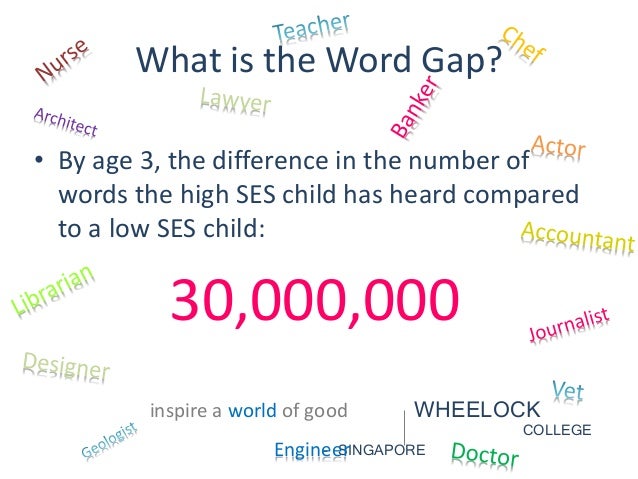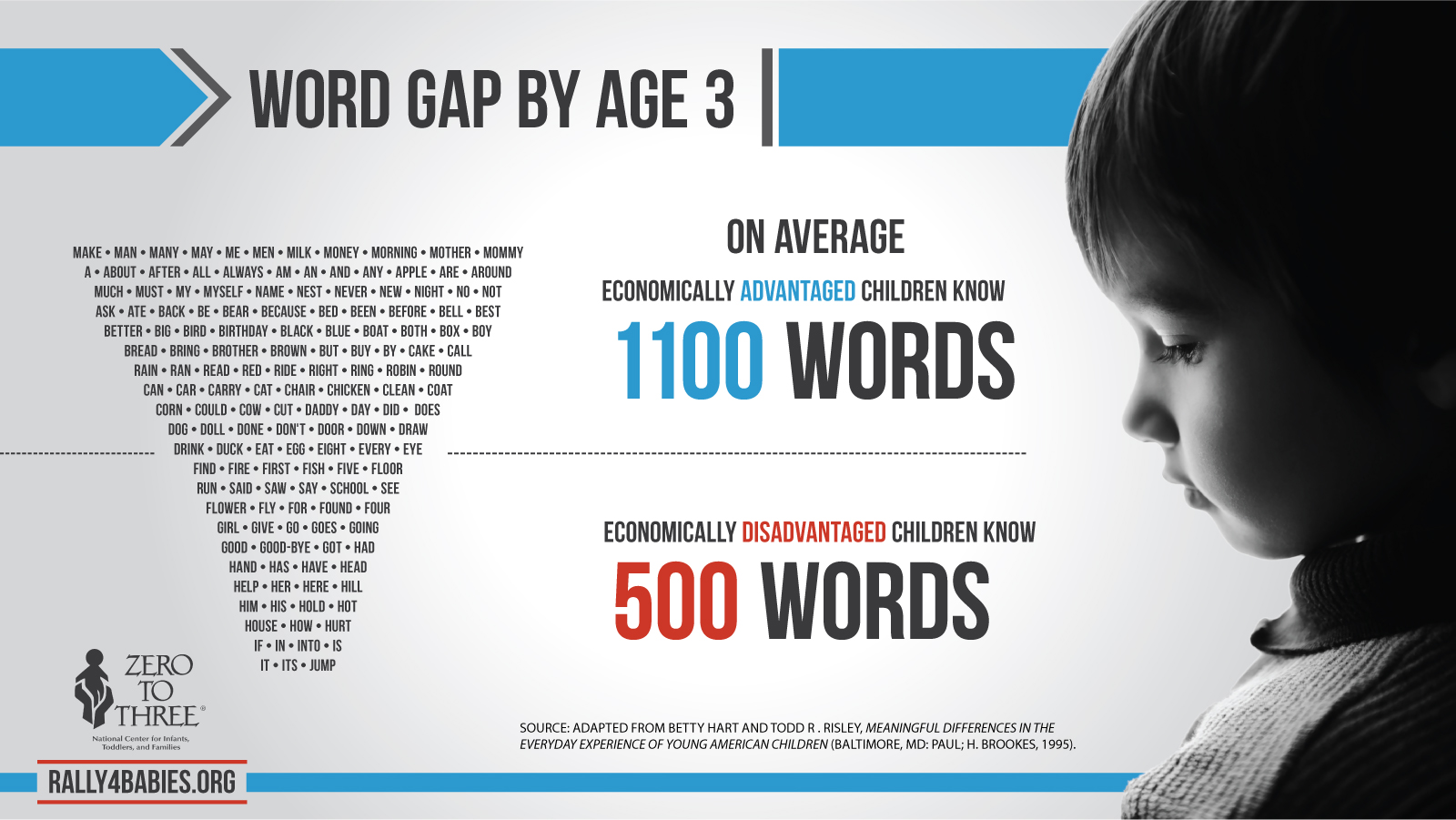
image source: https://www.slideshare.net/TrishaCraig/ecda-2014-closing-the-word-gap
video source: https://www.youtube.com/watch?v=779aFxFqrq4
I think the biggest take away that I got from last weeks discussion of chapters 4 & 5 was the quote that Mrs. Steffes gave us from the study, "Thirty Million Word Gap" which you can find here:
http://literacy.rice.edu/thirty-million-word-gap. Here is a breakdown:

image source: https://www.theodysseyonline.com/the-30-million-word-gap
image source: http://www.thisisliteracy.ca/resources/thirty-million-word-gap
What affect does hearing 30 million more words have on a child? Exposing children to more words increases the child's vocabulary. In the infographic below, higher SES children have a vocabulary that is more than double that of low SES children. This makes the difference in how many words they know and how well they can express themselves when they get to school.

image source: https://www.zerotothree.org/resources/1382-the-word-gap-by-age-3-infographic
Besides quantity, I also think there is a quality difference. I think higher SES children probably are exposed to more rich vocabulary and hear more positive comments. Here's more of a breakdown:
image source: http://www.tandembayarea.org/our-impact/facts-figures/
This will break it down even further.
image source: http://keywordsuggest.org/gallery/69951.html
That information makes me sad. It means that children in poverty are missing out on these moments:

image source: https://www.all4kids.org/importance-reading-children/

image source: https://www.nct.org.uk/parenting/reading-your-child
image source: http://monkeysee.com/importance-of-reading-to-baby/
image source: http://www.booktrust.org.uk/books/children/how-to-share-books/
image source: http://parentresourcecentre.com/instill-a-culture-of-reading/
image source: http://www.best-books-for-kids.com/babies-and-libraries.html
video source: https://www.youtube.com/watch?v=7qESE2GeZxo
In my other class, we read "Teaching with Poverty in Mind" by Eric Jensen. Both books can be found in our online college library (If you haven't taken Educ 198 or 298 yet, you can save money on your textbooks since they are free in the online Stafford Library). These books highlight how poverty can affect classroom performance and behavior. It also highlighted how a good teacher can help low SES students and raise their intelligence.
image source: http://shop.ascd.org/Default.aspx?TabID=55&productid=122852907&teaching/engaging-with-poverty-in-mind-2-book-set

image source: https://literacycoachmusings.wordpress.com/
I also like the exit emoji ticket idea. I think it is a simple and fun way to engage students. I would create the survey using Google forms. I want to save as much paper as I can. I would like for my classroom to be environmentally friendly.

image source: https://uk.pinterest.com/pin/658158933013241391/
Along the same lines, you could use this Facebook exit ticket.
image source: http://www.thebadpedagogue.com/plenaries.html
I like this one for international talk like a pirate day or if you had a pirate them.
image source: http://blog.teacherspayteachers.com/ahoy-matey-its-international-talk-like-a-pirate-day/
This one might be fun as well.
image source: http://www.thebadpedagogue.com/plenaries.html
This is cute:
image source: http://www.thebadpedagogue.com/plenaries.html
image source: http://www.thebadpedagogue.com/plenaries.html
image source: http://www.thebadpedagogue.com/plenaries.html
image source: http://www.thebadpedagogue.com/plenaries.html

image source: http://www.thebadpedagogue.com/plenaries.html

image source: http://www.thebadpedagogue.com/plenaries.html
image source: http://www.thebadpedagogue.com/plenaries.html
Mrs. Steffes gave another great resource for our lesson plan unit.

image source: http://www.educatorstechnology.com/2015/02/50-ways-to-do-formative-assessment-in.html
I like that she took the time to explain the difference between summative and formative assessments. Not all of my teachers have explained the assignments this well. What was your favorite part of last weeks readings and class discussion?
Wow Susan! There are so many good resources on your post this week! I was completely blown away when we discussed the 30 million gap. I knew there was a gap but I didn't realize the impact of the gap on the different levels. Reading to my children has been a priority since they were little and I continue to do it especially if they ask. I was pretty excited when my 10 year old daughter came home from the scholastic book fair with a book she thought would be good for me to read to them before bedtime! The importance of read alouds are the reason I will incorporate them in my daily instruction. Not only read alouds as "hooks" but also just for fun. I want to set aside at least 20 minutes everyday for a just for fun read aloud. This may be the only opportunity some of my students to be read too and I think this is a huge gift I can give my students.
ReplyDeleteI love all the check for understanding visuals posted, some of my favorites are the pirates, two stars and a wish, and the super hero. The variety would reach a diverse classroom and that is wonderful! Great post, Susan I enjoyed it!
The word gap is so astonishing! You have some great information in your post - very thorough. I have read both Teaching and Engaging with Poverty in mind. They are great books and really help to open your eyes to all of the different ways that poverty can present itself and the ways to help address it. I really enjoyed them, I am sure that you will too.
ReplyDeleteI LOVE all of your different exit slips! Very cute and creative.
I suspect that a couple of those exit slips are of UK origin: How did you "get on" in today's lesson? Anyway, I like the alien one because it makes you really think about how to explain something to someone who would most likely be clueless as to what you were talking about. The students kinda have to start from scratch with that one.
ReplyDeleteIt's amazing how much we are affected by our living conditions and environment, how it affects the actual brain. I know there will be students in my class who will not have to words to say or explain (or express in a healthy way) what is going on inside of them. It is important for their personal word gap to be filled in order for them to do well as a whole.
You have a ton of resources! I read Teaching and Engaging with Poverty in Mind as well. It has been a long time... I can't remember what course it was for. I will have to dust my copies off and refresh my memory:)
ReplyDeleteI'm bookmarking this post for when I teach this lesson next time! :)
ReplyDelete